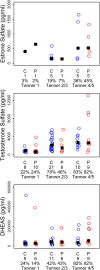Normal Pubertal Development in Daughters of Women With PCOS: A Controlled Study
- PMID: 27778640
- PMCID: PMC5413094
- DOI: 10.1210/jc.2016-2707
Normal Pubertal Development in Daughters of Women With PCOS: A Controlled Study
Abstract
Context: Daughters of women with polycystic ovary syndrome (PCOS) are thought to be at increased risk for developing stigmata of the syndrome, but the ontogeny during puberty is uncertain.
Objective: We phenotyped daughters (n = 76) of mothers with PCOS and daughters (n = 80) from control mothers for reproductive and metabolic parameters characteristic of PCOS.
Design, setting, and participants: We performed a matched case/control study at Penn State Hershey Medical Center that included non-Hispanic, white girls 4 to 17 years old.
Intervention: We obtained birth history, biometric, ovarian ultrasounds, whole-body dual-energy X-ray absorptiometry scan for body composition, 2-hour glucose challenged salivary insulin levels, and two timed urinary collections (12 hours overnight and 3 hours in the morning) for gonadotropins and sex steroids.
Main outcome measures: We measured integrated urinary levels of adrenal (dehydroepiandrosterone sulfate) and ovarian [testosterone (TT)] steroids. Other endpoints included integrated salivary insulin levels and urinary luteinizing hormone levels.
Results: There were no differences in detection rates or mean levels for gonadotropins and sex steroids in timed urinary collections between PCOS daughters and control daughters, nor were there differences in integrated salivary insulin levels. Results showed that 69% of Tanner 4/5 PCOS daughters vs 31% of control daughters had hirsutism defined as a Ferriman-Gallwey score >8 (P = 0.04). There were no differences in body composition as determined by dual-energy X-ray absorptiometry between groups in the three major body contents (i.e., bone, lean body mass, and fat) or in ovarian volume between groups.
Conclusions: Matched for pubertal stage, PCOS daughters have similar levels of urinary androgens and gonadotropins as well as glucose-challenged salivary insulin levels.
Copyright © 2017 by the Endocrine Society
Figures




Comment in
-
Letter to the Editor: "Normal Pubertal Development in Daughters of Women With PCOS: A Controlled Study".J Clin Endocrinol Metab. 2017 Jul 1;102(7):2560. doi: 10.1210/jc.2017-00555. J Clin Endocrinol Metab. 2017. PMID: 28899075 No abstract available.
-
Response to Letter: "Normal Pubertal Development in Daughters of Women With PCOS: A Controlled Study".J Clin Endocrinol Metab. 2017 Jul 1;102(7):2561. doi: 10.1210/jc.2017-00813. J Clin Endocrinol Metab. 2017. PMID: 28899078 No abstract available.
References
-
- McGee WK, Bishop CV, Bahar A, Pohl CR, Chang RJ, Marshall JC, Pau FK, Stouffer RL, Cameron JL. Elevated androgens during puberty in female rhesus monkeys lead to increased neuronal drive to the reproductive axis: a possible component of polycystic ovary syndrome. Hum Reprod. 2012;27(2):531–540. - PMC - PubMed
-
- Tanner JM. Fetus Into Man: Physical Growth From Conception to Maturity. Cambridge, MA: Harvard University Press;1989.
-
- Ibáñez L, Valls C, Ong K, Dunger DB, de Zegher F. Metformin therapy during puberty delays menarche, prolongs pubertal growth, and augments adult height: a randomized study in low-birth-weight girls with early-normal onset of puberty. J Clin Endocrinol Metab. 2006;91(6):2068–2073. - PubMed
Publication types
MeSH terms
Substances
Grants and funding
LinkOut - more resources
Full Text Sources
Other Literature Sources
Medical

